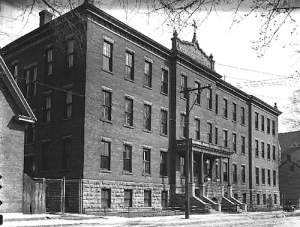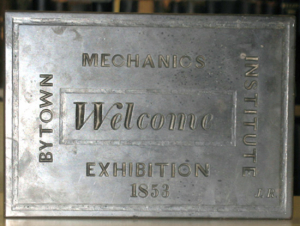A Look Back at the Ottawa Ladies’ College
Opened in 1872, the Ottawa Ladies’ College (OLC) was originally located on the southwest corner of Albert and Bay Streets before moving to its First Avenue location in 1914. Established as the expressed desire of many “earnest Protestant gentlemen” (including timber baron Henry Bronson) who represented the citizens of Ottawa and residents of Canada in their petition to form a school. The basis of this petition was to have a “first-class education put within the reach of the young women of the City of Ottawa and vicinity.” [2]
While private educational institutions, like convent schools and the Young Ladies’ Academy (founded in 1861) provided education to young women in Ottawa before the OLC was founded, what set the OLC apart was the designation as a college which provided education at the primary, secondary and collegiate levels. [3]
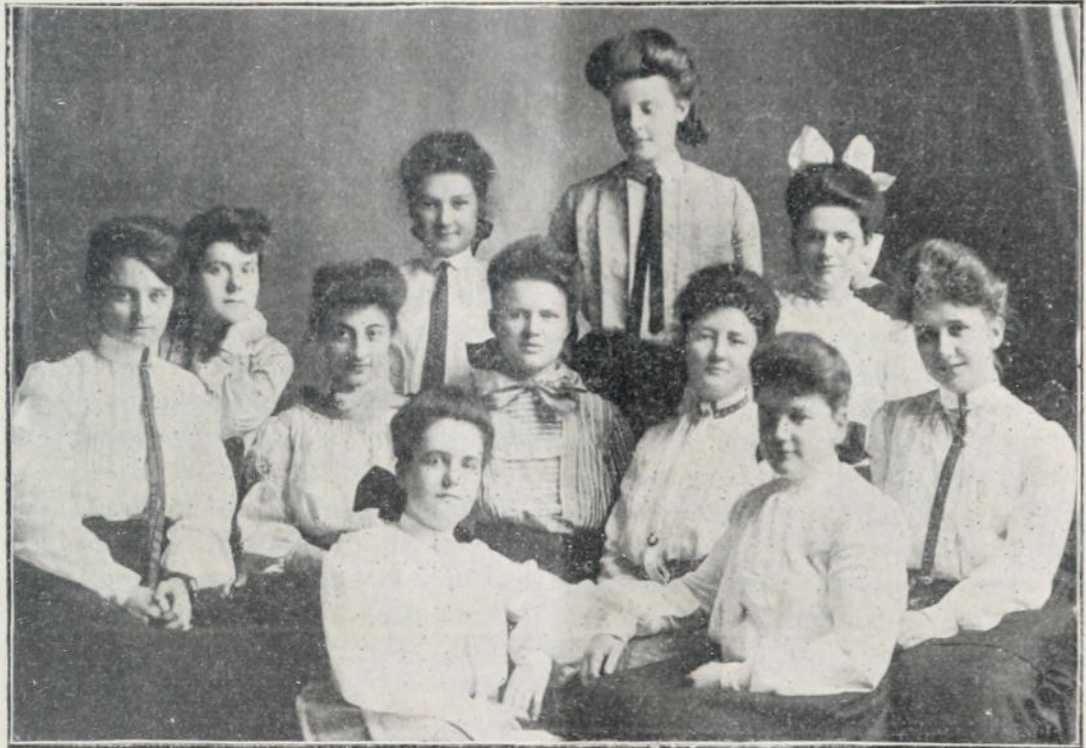 [Fig.2] The editors of the O.L.C. Echoes (student journal) April 1905 issue - University of Toronto Robarts Library Internet Archive Collection.
[Fig.2] The editors of the O.L.C. Echoes (student journal) April 1905 issue - University of Toronto Robarts Library Internet Archive Collection.
A primary aim of ladies’ colleges was to “assist in the moulding of character [and]. . . to afford refining influences.” [4] As the 1879 edition of the OLC school calendar states, this type of education offered a “good English education, together with the with the usual polite accomplishments for young women, under sound Evangelical, though non-sectarian influences.” [5] Ladies’ Colleges emphasized training in languages, classical studies, domestic science, fine arts and music. While at the same time, bookkeeping and stenography, mathematics and science were also included in the curriculum, particularly at the upper levels.
Though emphasis continued to be placed on education to further gendered social responsibilities, print media related to the promotion of the school reflects the OLC’s acknowledgment of the widening number of spheres in which women actively participated. As a 1921 article from the Ottawa Citizen articulates, the program of education adopted by the college was well-rounded, with the “aim of developing strong, intelligent, cultured and useful womanhood,” stating that “the commercial department provides a thorough business education; while in household arts, instruction is given in the most capable and efficient methods of keeping a home.” [6]
In addition to educational endeavours, the school boasted active social life for its students. Student organizations included the May Court Club (founded in 1898 by Lady Aberdeen), the Literary and Dramatic Club and the Athletic Association. Following their time at the college, alumnae maintained social connections through groups such as the Literacy Circle of the Alumnae Association.
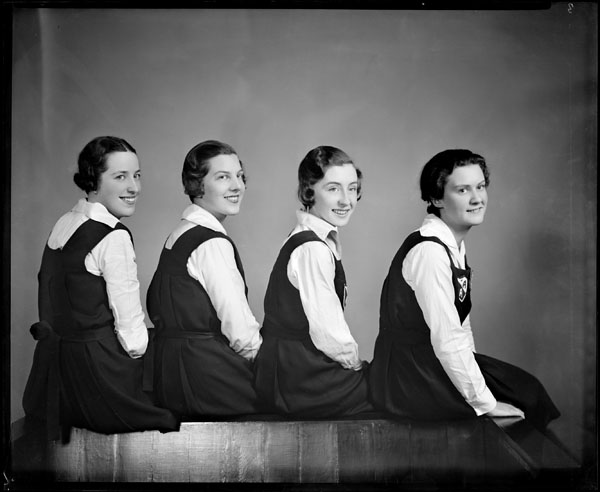 [Fig.3] Ottawa Ladies College Athletic Association (April 13, 1934) - Yousuf Karsh, Yousuf Karsh fonds, Library and Archives Canada, Accession 1987-054, e010678972.
[Fig.3] Ottawa Ladies College Athletic Association (April 13, 1934) - Yousuf Karsh, Yousuf Karsh fonds, Library and Archives Canada, Accession 1987-054, e010678972.
In 1942, the college decided to close following the takeover of the building by the Women’s Army Corps. Reflecting upon the legacy of the school, Chairman Colin Frasier Elliott told The Ottawa Journal that, graduates of the school have “gone out with a clearer recognition of their own reasonability as members of the community and the intensified desire to render service.” [7] In July 1942, in recognition of the “renowned institution,” the Women’s Canadian Historical Society of Ottawa displayed more than 125 photographs at the Bytown Museum which spanned the OLC’s seventy-year history. At the time of this exhibit, Mrs. James R. Dickson (who was an Alumnae of the college) was president of the Historical Society. [8]
In 1947, the building on First Avenue became the campus of the new Carleton College, which later evolved into Carleton University.
[1]. The college became sponsored by the Presbyterian church in 1879 and then was transferred to the French Board of Evangelization of the Presbyterian church in 1889. This transfer resulted in the name change to Coligny College to emphasize opportunities for French Protestant girls, however by 1897 had once again remained, this time to the Presbyterian Ladies’ College. By 1902, the name was reverted to its original name, Ottawa Ladies’ College, due to the board wanting to emphasis the college as non-denominational. Robin Sutton Harris, Constance Allen, Mary Lewis, An Annotated List of the Legislative Acts Concerning Higher Education in Ontario (Toronto: Innis College, University of Toronto, 1966), 57; Presbyterian Ladies’ College”The Ottawa Journal,August 3, 1897, 8, https://www.newspapers.com/image/43908436/; “Notice to Amend the Act Incorporation for Presbyterian Ladies’ College,” The Ottawa Journal,January 4, 1902, 2, https://www.newspapers.com/image/46099395 .
[2]. Province of Ontario, Statutes of the Province of Ontario 1869 (Toronto: Queen's Printer, 1870), 175, https://archive.org/details/statutesofprovin1869onta/mode/2up; Ottawa Ladies’ College, Catalogue of the Ottawa Ladies' College (Ottawa: Ottawa Ladies College, 1873), 3, https://www.canadiana.ca/view/oocihm.8_01621_1.
[3]. “Young Ladies' Academy,” Advertisement, City of Ottawa Directory for 1870-1871 (Ottawa: Hunter, Rose & Co., 1870), https://archive.org/details/opl-1870-71-OttawaCityDirectory/page/n243/mode/2up?q.
[4]. T. M. Macintyre, “Our Ladies’ Colleges in Relation to Our Educational System,” The Canada Educational Monthly and School Magazine (Feb 1885): 45, https://www.canadiana.ca/view/oocihm.8_04023_62.
[5]. Ottawa Ladies’ College, Ottawa Ladies' College, Ottawa: 1878/79 (Ottawa: A.S.Woodburn, 1979), 2, https://www.canadiana.ca/view/oocihm.8_01375_1.
[6]. “Has Wholesome and Refining Influence,” The Ottawa Citizen,August 12, 1921,14, https://www.newspapers.com/image/456386432/.
[7]. “Take Over Ottawa Ladies’ College for Canadian Women’s Army,”The Ottawa Journal,July 9, 1942, 5, https://www.newspapers.com/image/48213820.
[8]. “Ottawa Ladies' College Exhibit at Museum,”The Ottawa Citizen,July 31, 1942, 10, https://www.newspapers.com/image/456507722/.
Educational Resource List
In 2023 we asked ourselves the question – are there ways the Historical Society of Ottawa can be of assistance to teachers who would like to expand their students knowledge of the Ottawa area’s local history?
To that end, we have assembled an “Educational Resource List” and have made it available on our website. This Educational Resource List consists of more than 30 helpful links to specific stories from Ottawa’s past as well as links to additional resources. The links include short essays, pamphlets and video presentations from our own website, as well as links to third party resources that we strongly recommend. Various resources are suitable for group learning activities and/or independent study assignments.
We are happy to meet with teachers to further explore how we can be of assistance. We can also arrange for speakers to come to your classroom or to arrange walking tours. All free-of-charge. We are a non-profit, all-volunteer organization. It has been the Society's goal (since 1898!) to increase awareness of the Ottawa area’s fascinating history. (See Educational Resource List for full details and contact information.)
We welcome any suggestions you may have for the Educational Resource List. We hope to make it a resource that we can continually build upon.
Please let us know if you would like to part of the group of teachers who receive regular updates from us regarding our resources — and please feel free to share with other educators!
The Battle of the Hatpins
7 January 1916
The British North America Act, which established the Dominion of Canada in 1867, was an ambitious piece of legislation. In addition to uniting the Province of Canada, New Brunswick and Nova Scotia, the Act was crafted to meet the aspirations of its English and French communities as well as to guarantee the religious educational rights of Roman Catholics and Protestants.
The Act split the Province of Canada into the overwhelmingly English-speaking Ontario, and the predominantly French-speaking Quebec. Each could now exercise a wide range of powers in their respective jurisdictions without having to compromise with the other—a problem in the old Province of Canada where both, then called Canada West and Canada East, were equally represented in the legislature. With the English-speaking population growing rapidly relative to the French-speaking population, it was not politically feasible to maintain the original parity of seats in the House of Assembly between the two linguistic groups. The establishment of a separate Quebec ensured that French-speakers remained in control of their traditional territory within the Dominion.
Section 133 of the Act also guaranteed that both English and French would be used in the parliaments of Canada and Quebec as well as in federal and Quebec courts. Section 93 additionally recognized educational rights under which Roman Catholics in Ontario and Protestants in Quebec could attend their own schools distinct from the public-school systems of the two provinces.
The BNA Act was not perfect, however. Education, which was a provincial responsibility, was based on religion not language. While most francophones were Roman Catholic, not all Roman Catholics were francophone. This lack of congruence and the fact that the BNA Act did not speak to the language of instruction in delivering education were to become a flashpoint in English-French relations in Canada.
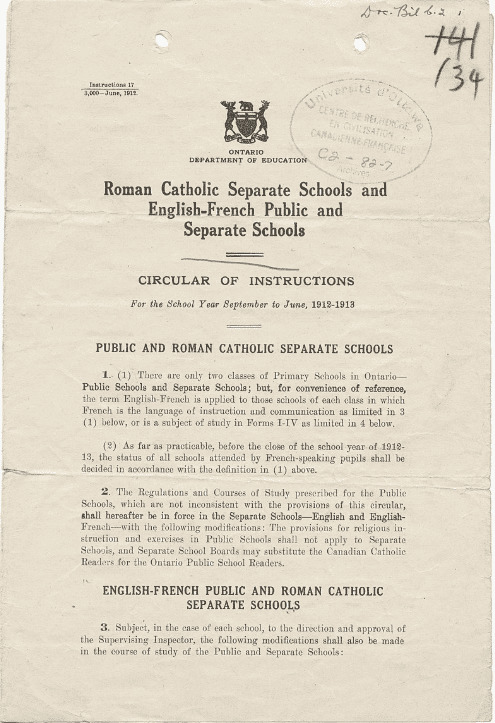 Cover page of Regulation 17 that restricted the use of French as the language of instruction in Ontario’s elementary schools, 1912, University of Ottawa.For many years after Confederation, minority French-speaking Ontarians attended separate elementary schools where French was used as the language of instruction. However, English-speaking Ontarians increasingly felt threated by the migration of French-Canadians into Ontario, especially into the eastern part of the province. By the end of the nineteenth century, the francophone population of Ontario had roughly doubled to 10 per cent. While English-speakers had to tolerate the use of French in Quebec and at the federal level given the BNA Act, they considered Ontario to be a British province in a British country. A growing French presence in Ontario was something that many could not abide.
Cover page of Regulation 17 that restricted the use of French as the language of instruction in Ontario’s elementary schools, 1912, University of Ottawa.For many years after Confederation, minority French-speaking Ontarians attended separate elementary schools where French was used as the language of instruction. However, English-speaking Ontarians increasingly felt threated by the migration of French-Canadians into Ontario, especially into the eastern part of the province. By the end of the nineteenth century, the francophone population of Ontario had roughly doubled to 10 per cent. While English-speakers had to tolerate the use of French in Quebec and at the federal level given the BNA Act, they considered Ontario to be a British province in a British country. A growing French presence in Ontario was something that many could not abide.
One way of ensuring that English remained predominant was through assimilation. In 1885, English became a compulsory subject in all elementary schools in Ontario. Five years later, English became the language of instruction in all schools except where the use of English was impracticable, i.e. when students were unable to understand English. Using this exemption, bilingual separate schools continued to teach in French.
In 1912, the Conservative Ontario government of Sir James Whitney toughened the legislation with the introduction of Regulation 17. The Regulation forbade the use of French as the language of instruction beyond grade 2 in Ontario’s separate schools. When Ottawa’s separate schools ignored the regulation, the government followed up with Regulation 18 which revoked the teaching certification of instructors who persisted in teaching in French, making them “unqualified to teach,” and rescinded financial support for school boards that defied Regulation 17. Ottawa’s bilingual separate schools continued to resist.
Fighting the French cause was the French-Canadian Education Association of Ontario (l’Association canadienne-française d’éducation d’Ontario), led by Senator Napoléon Antoine Belcourt. The Association was supported by Ottawa’s French-speaking, Roman Catholic clergy. The Ottawa newspaper Le Droit was also a powerful advocate. It was founded in 1913 for the express purpose of supporting the city’s francophone community in its struggle for its rights. Note that Ottawa’s French-Canadians repeatedly said that they strongly supported the study of English, which they viewed as necessary in a largely anglophone province. They just wanted to protect the language of their forebears and culture.
On the government’s side in support of Regulation 17 were two unlikely allies–the politically powerful Orange Order, which consisted of mainly Irish Protestants who were fiercely anti-Catholic and pro British Empire, and Irish Roman Catholics.
Relations between Irish Catholics and their French-speaking co-religionists in Ottawa had never been good. And they deteriorated further with the influx of francophones as the two Catholic communities competed for dominance. So strained were the relations that in 1915 Father Whelan of St. Patrick’s Church in Ottawa wrote an open letter to Cardinal Bégin of Quebec, under whose jurisdiction the Diocese of Ottawa fell, and to Sir Lomer Gouin, the Premier of Quebec, complaining that it was French Canadians who were stirring up racial feeling, introducing intolerance and inflaming public feeling.
One front of this Irish-French battle was Ottawa’s Separate School Board. Led by Mr. Samuel Genest, its majority francophone chairman, the board had refused to implement Regulation 17 over the objections of its minority, English-speaking, Irish-Catholic trustees. This led to the loss of the provincial education subsidy, affecting both French- and English-speaking students alike. Relations between the co-religionists nose-dived when, at the behest of the English-speaking trustees, the court issued an injunction to stop the board from paying the salaries of “unqualified” French-speaking teachers—32 Christian brothers and four nuns. In response, Genest refused to pay English-speaking teachers. As a consequence, all teachers went for months without a pay cheque.
To circumvent Genest and the francophone-dominated board, Ontario’s Department of Education paid the English teachers their salaries and arrears directly. Bilingual teachers. i.e. French teachers, were not paid. Subsequently, the Ontario government passed legislation establishing a three-man commission, consisting of two anglophones and one francophone in the summer of 1915 to replace Ottawa’s elected separate school board.
The start of the school year in September 1915 saw the government-appointed commission and the elected separate school board vying for control of the schools. Two young sisters, Béatrice and Diane Desloges, who had been appointed by the school board began teaching in French at the Guigues School at 159 Murray Street in Lowertown in defiance of both the commission and an order by the Superior Court of Ontario. Declaring the two sisters “unqualified” to teach since they would not abide by Regulation 17, the commission hired two replacement teachers, the Misses Lafond, to instruct their classes in English. When the Lafond sisters turned up at Guigues School, they found empty classrooms. Their students, with the support of their parents, had decamped to the chapel to continue their instruction by the Desloges sisters in French. Subsequently, the Desloges sisters conducted their classes in rooms at the corner of Guigues and Dalhousie Streets.
Matters came to a head when schools reopened in January 1916 after the Christmas holidays. On the first day back, fifty people, mostly women, escorted the Desloges sisters from their make-shift classrooms to the Guigues School. Entering the school with the mothers, the two young teachers took charge of roughly ninety boys and began instructing them in French. When the two Lafond sisters showed up at 9:00 am, they found their entry into the school blocked. The francophone mothers, armed with hatpins to ward off any assault by police or supporters of Regulation 17, brought in provisions and set up a makeshift kitchen in case of a lengthy siege.
The chairman of the government-appointed school commission, Mr. Denis Murphy, thundered that he intended to deal with the situation “with an iron hand,” and that “sterner measures” would be taken that coming Friday if the francophone mothers and teachers persisted in their efforts. Meanwhile, female lookouts were posted to watch out for police and supporters of Regulation 17. An Ottawa Journal reporter called them “a twentieth-century rejuvenation of the women of the French Revolution.” There was, however, no trouble. Despite rumours that police had been asked by the commission to storm the school, the police did not show up.
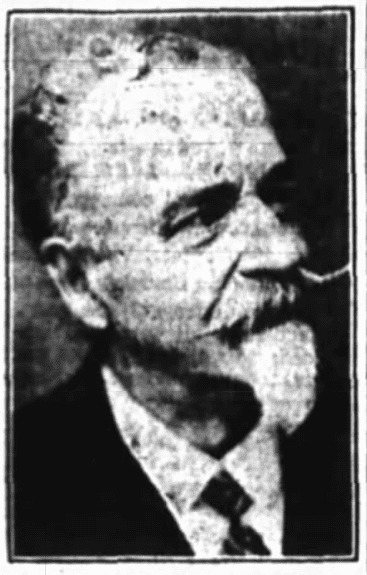 Samuel Genest, Chairman of the Separate School Board of Ottawa, Ottawa Journal, 26 April 1937.The peace was temporary. On Friday, 7 January 1916, the commission acted, sending in more than twenty-five policemen to take control of Guigues School. They managed to enter the building when the doors were opened to admit some Christian brothers who taught at the school, but later retreated in face of stout resistance from the mothers. One constable had his thumb bitten and another received a black eye. While the fracas was underway, the Desloges sisters entered the school by a side door and were carried shoulder high by the mothers to their classrooms located on the second floor of the building. On reaching her classroom, one of the sisters waved through an open window overlooking Murray Street, receiving a loud cheer from her supporters below.
Samuel Genest, Chairman of the Separate School Board of Ottawa, Ottawa Journal, 26 April 1937.The peace was temporary. On Friday, 7 January 1916, the commission acted, sending in more than twenty-five policemen to take control of Guigues School. They managed to enter the building when the doors were opened to admit some Christian brothers who taught at the school, but later retreated in face of stout resistance from the mothers. One constable had his thumb bitten and another received a black eye. While the fracas was underway, the Desloges sisters entered the school by a side door and were carried shoulder high by the mothers to their classrooms located on the second floor of the building. On reaching her classroom, one of the sisters waved through an open window overlooking Murray Street, receiving a loud cheer from her supporters below.
The mothers guarded the doors, corridors and staircases of the school, ready for another police sortie. More police arrived on the scene to take up positions around the school. The Journal commented that it would have taken “only a breath to turn the whole bilingual situation into a pitched battle and rioting.” Fortunately, calmer heads prevailed. The police withdrew, leaving the field of the “Battle of the Hatpins” in the hands of the francophone mothers.
With the Guigues School “occupied” by the women, the war shifted to the courts. In the meantime, the government-appointed school commission refused to pay the bilingual teachers. Senator Belcourt, the head of the French-Canadian Education Association, tested the constitutionality of Regulation 17 in Ontario’s Courts. Losing his case there, he took the matter to the Privy Council in London, then Canada’s highest court of appeal. In November 1916, the Privy Council ruled on two issues—the legality of the government appointing a school commission to replace the recalcitrant school board and, more fundamentally, the legality of Regulation 17. It came down with a split decision. It ruled against the commission, calling its appointment ultra vires. However, the Privy Council sustained Regulation 17.
While opponents of Regulation 17 were disappointed by the second decision, they were philosophical about it. Le Droit opined that while they had suffered a setback, it gave them a reason to close ranks and unite. The fight was not yet over. With the government-appointed commission declared illegal, the old school board headed by Samuel Genest regained control of all separate schools in Ottawa. One of the board’s first acts, in defiance of the government and the court injunction brought against it by the English-speaking board trustees, was to pay the salaries and arrears owed to the bilingual teachers, many of who had been unpaid since September 1914.
Legal suits began to fly as the school board wrested control of funds held in local banks in the name of the now illegal and defunct school commission. It also sued members of the commission. Concurrently, the minority English-speaking board trustees continued their campaign against paying the bilingual teachers who refused to comply with Regulation 17. Samuel Genest, who appeared in multiple court hearings, was threatened with jail for contempt of court owing to his refusal to turn over evidence showing that the separate school board had paid “unqualified” teachers. When he finally did, the suggestion of jail was quietly dropped even though the pay stubs clearly showed that the board had paid the bilingual teachers in defiance of the government.
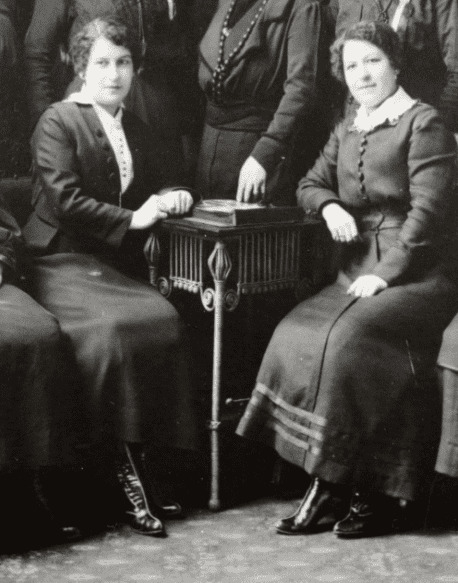 Diane and Béatrice Deloges, les gardiennes de Guigues, Author unknown, University of Ottawa.In the end, the government did not have the political appetite to pursue the issue further. French continued as the language of instruction at Guigues School despite the regulation. In 1925, with the political winds shifting, Premier Howard Ferguson, who had been the Minister of Education during the Battle of the Hatpins, appointed the Scott-Merchant-Côté Commission to look into the bilingual issue. Two years later, the government stopped enforcing Regulation 17 province-wide, and instruction in French resumed in Ontario schools. This decision, which was controversial in many Conservative circles, caused The Telegram, a Toronto-based newspaper, to claim with considerable hyperbole that English would be abolished in great areas of Ontario. Regulation 17 remained on Ontario’s statute books until 1944.
Diane and Béatrice Deloges, les gardiennes de Guigues, Author unknown, University of Ottawa.In the end, the government did not have the political appetite to pursue the issue further. French continued as the language of instruction at Guigues School despite the regulation. In 1925, with the political winds shifting, Premier Howard Ferguson, who had been the Minister of Education during the Battle of the Hatpins, appointed the Scott-Merchant-Côté Commission to look into the bilingual issue. Two years later, the government stopped enforcing Regulation 17 province-wide, and instruction in French resumed in Ontario schools. This decision, which was controversial in many Conservative circles, caused The Telegram, a Toronto-based newspaper, to claim with considerable hyperbole that English would be abolished in great areas of Ontario. Regulation 17 remained on Ontario’s statute books until 1944.
Many people were involved in this fight for French-language education rights. Among the most prominent were Senator Belcourt of the French-Canadian Education Association, and Samuel Genest, the chairman of the Separate School Board of Ottawa. However, without the fortitude of the anonymous mothers of the children of Guigues School, and the bravery of Beatrice and Diane Desloges, who were barely into their twenties, it’s doubtful that the Ontario government would have given up the fight as quickly as it did. The Desloges sisters, known as les gardiennes de Guigues, became the symbol of French resistance to what many saw as an oppressive government.
In 1984, Ontario finally officially recognized the right of Franco-Ontarians to receive French-language education in the province’s elementary and secondary schools. In 2016, one hundred years after the Battle of the Hatpins, the Ontario government of Kathleen Wynne apologized to the province’s French-speaking community.
According to the Office of the Commissioner of Official Languages, French-speaking Ontarians numbered more than 622,000 in 2016, accounting for roughly 4.3 percent of Ontario’s population.
159 Murray Street, the former Guigues School, has been converted into condominiums and is a heritage building.
Sources:
Barber, Marilyn, 1966. “The Ontario Bilingual Schools Issue: Sources of Conflict,” Canadian Historical Review, Vol. XLVII, No. 3 September.
Gazette (Montreal), 1915. “Voice of Ontario Irish Catholics,” 15 February.
———————–, 1915. “Attacks Father Whelan,” 1 March.
———————–, 1916. “Left In Control Of Guigues School,” 15 January.
Le Droit, 1916. “L’imbroglio scolaire à Ottawa,” 7 janvier.
———-, 1916. “Autour de l’école Guigues,” 10 janvier.
———-, 1916. “Texte Complet des Deux Jugements du Conseil Prive,” 3 novembre.
———-, 1916. “Le Jugement du Roi,” 3 novembre.
Mestral, Armand L. C. & Fraiberg, William, 1966. “Language Guarantees and the Power to Amend the Canadian Constitution,” McGill Law Journal, https://lawjournal.mcgill.ca/wp-content/uploads/pdf/1302064-mestral.pdf.
Musées Ontario Museums, 2020. Diane Deloges (1892-1945) & Béatrice Desloges (1895-1957), https://mon400.com/histoires/les-soeurs-desloges/.
————————————, 2020. Le Réglement 17 (1912), https://mon400.com/histoires/reglement-17/.
Office of the Commissioner of Official Languages, 2019. Infographic: The French Presence in Ontario, https://www.clo-ocol.gc.ca/en/statistics/infographics/french-presence-ontario.
Ontario, Government of, 2016. Ontario Apologizes for 1912 Law on French in Schools, https://news.ontario.ca/opo/en/2016/02/ontario-apologizes-for-1912-law-on-french-in-schools.html.
Ottawa Citizen, 1915. “Women Storm School, Close Teachers Out,” 5 January.
——————, 1915. “Pickets On Duty Today,” 6 January.
——————, 1915. “Many Teachers Have Not Yet Been Paid,” 11 January.
——————, 1915. “Education Department Puts Up Money And The English Teachers Get Their Pay,” 1 June.
——————, 1915. “Injunction Not Obeyed By Teachers,” 5 October.
——————, 1916. “Trouble Will Resume Today,” 7 January.
——————, 1916. “All Quiet At Guigues School,” 10 January.
——————, 1916. “Ontario Act Re English-French Schools Sustained By Highest Tribunal; S.S. Board Restored,” 3 November.
——————, 1916. “Salaries Paid The French Staff By School Board As ‘Act of Simple Justice,’” 27 December.
———————, 1917. “Move to Commit The Chairman Of Separate School Board,” 30 April.
———————, 2017. “One Language, Two Sisters, & Several Hatpins,” 13 March.
Ottawa Journal, 1914. “The Bilingual Trouble,” 31 December.
——————-, 1915. “Sam Genest Takes Possession Amid Clashing Of Bells And Ceremonies,” 1 September.
——————, 1915. “Defiant Attitude Of Teachers Ends In Certificates Being Suspended,” October 14.
——————, 1916. “Police Are Ordered To Guigues School To Disperse Bilingualists Who Have Captured It And Turned Out Teachers,” 5 January.
——————, 1916. “May Order Arrest Of Lady Teachers,” 5 January.
——————, 1916. “Guigues School Is Seized By Police, But They Receive Withdrawal Order,” 7 January.
——————, 1916. “The Guigues School Well Entrenched,” 11 January.
——————, 1917. “Genst Examined By Local Master,” 19 May.
——————, 1917. “Do Not Expect Mr. Genest Will Be Sent To Jail,” 19 October.
——————, 1937. “Died on Sunday,” 26 April.
Pelletier, Jean Yves, 2007. “The Guigues Elementary School in Ottawa,” Encyclopedia of French Cultural Heritage in North America, http://www.ameriquefrancaise.org/en/article-723/The_Guigues_Elementary_School_in_Ottawa.html
Windsor Star, 1927. “‘Face About’ Is Assailed,” 29 September.
Story written by James Powell, the author of the blog Today in Ottawa's History.
Retired from the Bank of Canada, James is the author or co-author of three books dealing with some aspect of Canadian history. These comprise: A History of the Canadian Dollar, 2005, Bank of Canada, The Bank of Canada of James Elliott Coyne: Challenges, Confrontation and Change,” 2009, Queen’s University Press, and with Jill Moxley, Faking It! A History of Counterfeiting in Canada, 2013, General Store Publishing House, Renfrew, Ontario. James is a Director of The Historical Society of Ottawa.
Mechanics Institutes
28 January 1847
Not very many people in early Ottawa had the educational advantages of today's society—many wished for it, but had to leave school, where it existed, as soon as they were of money earning age Those who could afford a classical or technical education tended to be those whose parents had already had some measure of success. Technical knowledge came through apprenticeship and on the job learning. Women and girls were almost excluded from the education systems that did exist. However, a good portion of those already educated believed that all persons were educable and education was the key to a better society, both socially and economically.
Most factory workers preferred relaxing in the local pub with their buddies.
In the early 1820's organizations called Mechanic's Institutes were begun in Great Britain and the United States, dedicated to “improving the mind of the working class”. In Bytown in the 1840's several attempts were made to establish similar institutions but final success did not come until 1853. The institutes were aimed at factory workers but were more used by clerks and shop assistants. After the typical 12-14 hour day of the times. Most factory workers preferred relaxing in the local pub with their buddies. Late closing on work days led to letters to the Bytown Gazette in 1837 suggesting both a movement for earlier closing and the opening of a Newsroom or a library. By 1838, as it happened, two Newsrooms had opened—one in the Upper Town's British Hotel and one in the Lower Town's McArthur's Hotel. The Lower Town Newsroom closed by 1844, but there is a record of a gathering of “clerks” in the British Hotel in 1845.
On January 28, 1847 there was a meeting of prominent citizens in the Oddfellow's Hall to create a Bytown Mechanic's Institute. All resident clergymen were members of the founding Council as were magistrates, factory owners, the current Mayor (John Scott) and a past Mayor and City Clerk. Despite their best efforts at fund raising and the purchase of a collection of books (210 available in 1848), the Institute became defunct in 1849. The organizers wanted to show Bytown as progressive. In early 1853, a provisional committee with the strong support of Robert Bell publisher of the Ottawa Citizen was struck to start a “Bytown Mechanic's Institute and Athenaeum”. Again, prominent men were involved. Judge C. Armstrong, Dr. S Sewell, Elkanah Billings, Richard W. Scott Mayor H. J. Friel and Thomas McKay, among others,. formed the committee. At the time, Bytown was a flourishing town of 8000 souls.
A Province of Canada Act was passed in 1853, establishing the Mechanic's Institute in Bytown. Fees were set at $5 per annum. While this fee may seem small today, it could be as much as one week's salary for a working man then. This may have been a factor in the later history of the Institute. We now enter a phase when the idea of training for working class people gradually gave way to a club largely for intellectuals of the day. The organization apparently died in 1907 as professional societies, museums and public libraries proliferated in Ottawa. The highest point of Institute membership was 438 in 1866/67. At a general meeting in 1867 a recorded vote of 109 attendees showed the following mix—13 professionals, 16 merchants, 12 civil servants, 3 lumber merchants, 16 in service industries 10 bookkeepers and clerks, one farmer, 4 labourers, 2 servants, 2 gentlemen and 20 where no occupation was given. Hardly representative of workers!
The Society's activities in the1880's and the 1890' were confined to winter lectures and the maintenance of the library. In 1902, the President still felt the Society's activities were useful but the handwriting was on the wall with the opening of the Carnegie public library in 1906. In November 1906, Dr. Otto Klotz, the President still promoted the work of the Society but stated “the great mass of the people is not hungering for intellectual development but is rather in search of amusement entertainment and forms of diversion as involve little or no mental effort”.
R. Forbes Hirsch who researched the history of Mechanic's Institutes had the following comments in a 1991 publication. “It cannot be said that the Institute suffered from competition in its early days for the limited leisure time of the residents they hoped to attract—the only competition were the pubs, worship services and other church activities. ” Hirsch felt that what really evolved was a social club where the lecture topics were of more interest to better educated middle and upper class citizens. For workers who put in long hours by today's standards and who really couldn't afford the fees charged, th eidea was great, but the implementation suffered from many problems.
Cliff Scott, an Ottawa resident since 1954 and a former history lecturer at the University of Ottawa (UOttawa), he also served in the Royal Canadian Air Force and the Public Service of Canada.
Since 1992, he has been active in the volunteer sector and has held executive positions with The Historical Society of Ottawa, the Friends of the Farm and the Council of Heritage Organizations in Ottawa. He also inaugurated the Historica Heritage Fair in Ottawa and still serves on its organizing committee.



![[Fig.1] Coligny College - Ladies' College [Ottawa Ladies’ College] (September 1895) 1](/media/k2/items/cache/d7a332411e14769f300879cf8b1d4da6_Generic.jpg?t=20250513_200154)

